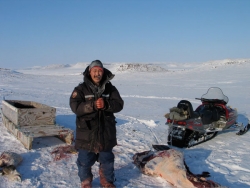The subsistence practices of arctic peoples have long occupied the attention of social scientists working in the north. Research over the past four decades has established the continued importance of subsistence hunting to both the economies of northern communities and the maintenance of Inuit identity at a time of rapid social change. Generally speaking, this research has documented that subsistence hunting continues to be an important source of food for Inuit, but hunting from a modern settlement requires access to a variety of resources. Hunters require money, obtained through wage labor, to acquire the equipment and fuel used for hunting, as well as access to traditional capital (tools and kin connections) to engage effectively in the subsistence economy. Successful hunting also requires a significant store of traditional knowledge about animals and the environment.

Larry Olifie, a resident of Ulukhaktok butchering a muskox on Holman Island in March of 2007. Meat from this animal was given to his father and siblings, and some of the animal was used to feed his father's dog team. Photo courtesy of Peter Collings.
As part of a project funded by the NSF Arctic Social Sciences program, Peter Collings of the University of Florida and George Wenzel of McGill University have been conducting fieldwork in two Inuit communities, Ulukhaktok (formerly Holman) in the Western Canadian Arctic and Clyde River on Baffin Island, to collect comparative data on contemporary Inuit hunting and economic strategies. Their research, which focuses on a cohort of adults born between 1955 and 1970 and raised primarily in these communities, is aimed at understanding the challenges that this generation of Inuit have faced as they confront a rapidly changing economy, society, and climate while retaining their cultural identity.
Collings and Wenzel worked with the same group of people between 1992 and 1994 in another study exploring the same issues, which has allowed for an understanding of how these communities have changed over time and how those changes affect Inuit. Initial results from Ulukhaktok suggest that over a 15-year period, Inuit have faced increasing economic burdens in terms of the stagnation of real wages and increases in the costs of living. Economically, Inuit in this cohort are considerably worse off today than they were when Collings and Wenzel initially began their work in the 1990s.
While data collection continues in Clyde River, initial analysis of food sharing data from Ulukhaktok has focused on the patterns of food sharing between hunters and recipients that differ in degree of relatedness (kinds of kin) and how different strategies for generating money result in different patterns of interaction between community residents. Preliminary analysis of connections between economic strategies and kinds of kin demonstrate that Inuit who self-identify as hunters while pursuing a strategy of casual wage labor and/or provide guide services to sport hunters commonly share subsistence food with their extended families and more distantly related kin. Inuit who are engaged in full-time employment, on the other hand, tend to focus their subsistence food exchanges within their nuclear families.
Study results also suggest that, on one level, engaging in full-time wage labor as an economic strategy is socially isolating when it comes to the movement of subsistence food and, by extension, limits access to knowledge and material items used in subsistence. On the other hand, hunters who connect with a larger number of distant kin and non-kin can use those connections to gather and share information and material related to successful hunting.
These differences in sharing patterns also have deeper implications, especially in the context of a rapidly changing climate. If the ability for a settlement to adapt is predicated upon the ability of a group of people to act collectively, for example, then contemporary economic trends that encourage wage labor and discourage subsistence hunting are troubling, since wage employment fosters the isolation of individuals within the community. Furthermore, although it seems that an economic strategy focusing on subsistence hunting at the expense of wage labor might provide the flexibility to adapt to changing circumstances, such as those presented by climate change, social forces may effectively prevent many Inuit from pursuing such a strategy.
Detailed analysis of food networks in Ulukhaktok continues, and the results will be compared with data currently being collected in Clyde River. Once complete, a comparison between the settlements at both times (1992–1994 and 2007–2009) will allow for a more complete understanding of changing patterns over time and specific social and economic conditions that may influence decisions about sharing.
In May 2009, an article describing Colling’s experiences with participant observation as a research strategy in these communities appeared in the journal Field Methods. A paper on this project is also under review at the journal Arctic, and final reports will be made to the communities of both Ulukhaktok and Clyde River.
For more information, contact Peter Collings (collings [at] anthro.ufl.edu, 352-392-2253, Ext. 239).
